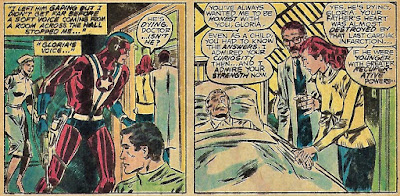The nature of shared universe comics is that when reading them, they lead you to discover more comics that you also want to read. This is their curse and their blessing all at once. Hence, it was while reading All-Star Squadron that I discovered the existence of Steel, the Indestructible Man, a comic set on Earth-Two during World War II, and so I decided to catch up on it before wrapping up my WWII-set comics with The Young All-Stars.
Steel was created by Gerry Conway, a mainstay of DC in the 1970s and 1980s; around the time he wrote this, he was also working on Superboy and the Legion of Super-Heroes, All Star Comics, and Justice League of America, among many others. I haven't found Conway's work on team books to be very interesting most of the time,* but Steel reads differently than the others. I don't want to falsely attribute motives to him, but Steel reads like something he wrote because he was in love with the idea, rather than because he'd been assigned to and was capable of putting out serviceable work at great volume. The lettercol of issue #2 indicates that he was inspired by the research he did while writing the WWII-era adventures of the Earth-Two Wonder Woman to come up with his own WWII hero.
Steel is set about a year before America entered the war, when many Americans believed we shouldn't be involved at all. Steel is Hank Heywood, a promising medical student who gave up his career after a trip to Poland where he saw Nazi brutality firsthand, and enlisted in the Marines. Injured while taking down a saboteur, he survived only because of an experimental surgery by his old mentor, who use "bio-retardant" to heal his wound and enable his body to accept steel beams and motors in place of damaged bones and muscle. But after his surgery, he realizes he can use his newfound strength and durability to fight for the cause in a more direct way.
 |
| from Steel, the Indestructible Man #1 (art by Don Heck & Joe Giella) |
Additionally, Conway does some of his finest scripting here; much of the series is narrated in the first person by excerpts from Heywood's journal, which gives the whole series a strong sense of personality. Don Heck is an artist I can't claim to have thought much about (my notes tell me I have reviewed seven previous comics he's worked on, but in none of those reviews did I ever mention his work aside from All-Star Squadron), but here he does great work. Like the best superhero comics artists, he draws cleanly and clearly, and is also good at communicating character. Steel's costume might be over-the-top, but it's also entirely appropriate, and presents a strong image. And some of the stories have some good zip to them, like the one where Steel confronts a newspaper mogul over his complicity in a friend's betrayal.
 |
| from Steel, the Indestructible Man #5 (art by Don Heck & Frank Chiaramonte) |
Interestingly, nothing in the first five issues definitively places it on Earth-Two; though Superman, the Sandman, the Flash, and Hawkman would have been active by this point (among others), no one ever mentions them or calls Steel a superhero. If #6 had been published, however, it would have featured the origin of Baron Blitzkrieg, a character Conway and Heck created for the Earth-Two Wonder Woman comics... but there never was an issue #6. Steel was a victim of the so-called "DC Implosion," one of seventeen comics cancelled overnight. Issue #5 previews a #6 that never appeared, and Conway and Heck had even written and pencilled the issue.
That wasn't the end of Steel, though; Roy Thomas brought the character into the All-Star Squadron, a natural fit if there ever was one, given the common vibe of both series. Thomas even took the completed issue #6 and worked it into All-Star Squadron, using it as flashbacks in A-SS #8-9 to explain how Steel came to be involved in that adventure of the Squadron. I reread #8-9 to cap off Steel, and found them more interesting with the context of knowing who Steel was and wanting to see his adventures continue. Steel would continue as an A-SS member up through the Crisis, and his grandson would also star in Justice League in the 1980s, which I look forward to reading someday.
Steel, the Indestructible Man was originally published in five issues (Mar.-Nov. 1978). The series was created and written by Gerry Conway; designed by Don Heck; pencilled by Don Heck (#1-5) and Juan Ortiz (#3-4); inked by Joe Giella (#1, 3-4), Vince Colletta (#2), Bruce Patterson (#3-4), and Frank Chiaramonte (#5); lettered by Ben Oda (#1-3), Todd Klein (#3), Clem Robins (#4), and Karin (#5); colored by A. Tollin (#1), Adrienne Roy (#2), Bob LeRose (#3-4), and Jerry Serpe (#5); and edited by Allen Milgrom.
* Lest it sound like I hate all Gerry Conway work, I actually really enjoyed some of his Crisis crossovers, especially the "Crisis on New Genesis" one. Plus I liked Sun Devils, but that came later.
This post is the thirteenth in a series about the Justice Society and
Earth-Two. The next installment covers Superman vs. Wonder Woman: An Untold Epic of World War Two. Previous installments are listed
below:
- All Star Comics: Only Legends Live Forever (1976-79)
- The Huntress: Origins (1977-82)
- All-Star Squadron (1981-87)
- Infinity, Inc.: The Generations Saga, Volume One (1983-84)
- Infinity, Inc.: The Generations Saga, Volume Two (1984-85)
- Showcase Presents... Power Girl (1978)
- America vs. the Justice Society (1985)
- Jonni Thunder, a.k.a. Thunderbolt (1985)
- Crisis on Multiple Earths, Volume 7 (1983-85)
- Infinity, Inc. #11-53 (1985-88) [reading order]
- Last Days of the Justice Society of America (1986-88)
- All-Star Comics 80-Page Giant (1999)

No comments:
Post a Comment